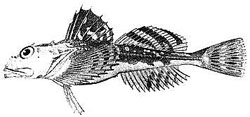| Sculpin Temporal range: | |
|---|---|
 | |
| Myoxocephalus octodecemspinosus | |
| Scientific classification | |
| Kingdom: | Animalia |
| Phylum: | Chordata |
| Class: | Actinopterygii |
| Order: | Perciformes |
| Suborder: | Cottoidei |
| Superfamily: | Cottoidea Gill, 1889 [1] |
A sculpin is a type of fish that belongs to the superfamily Cottoidea in the order Perciformes. [2] As of 2025, this superfamily contains 5 families, 112 genera, and 405 species. [3] [4]
Contents
Sculpins occur in many types of habitat, including ocean and freshwater zones. They live in rivers, submarine canyons, kelp forests, and shallow littoral habitat types, such as tidepools. [2]



